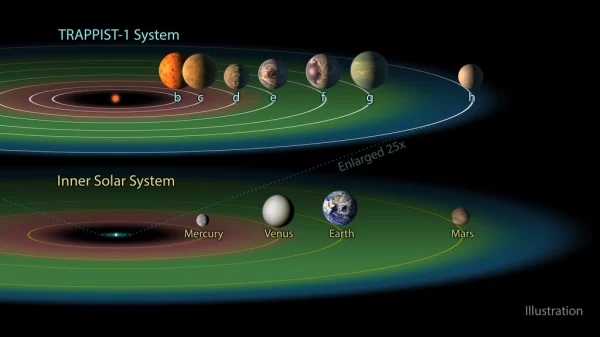Space exploration has always been one of the most captivating topics, not only due to its mysteries but also because of groundbreaking discoveries that could change our perception of the universe and life itself. Recently, a groundbreaking discovery from NASA’s Kepler mission has sparked new hope for the possibility of finding life beyond Earth. Astronomers from Cornell University have discovered three planets with the potential to support life, located in the “habitable zone” of M-type dwarf stars, opening a new door for research on exoplanets outside our Solar System.
Planets in the “habitable zone” are those with the right temperature for water to exist in its liquid form, a crucial element for life as we know it. To achieve this, planets must orbit their host star at a distance that is neither too close nor too far. If too close, water would evaporate due to excessive heat; if too far, water would freeze. This is why planets in the “habitable zone” receive such special attention from scientists.

The researchers from Cornell used data from the Kepler telescope, a NASA project, to observe more than 80 M-type dwarf stars, a group of stars that make up a large portion of the stars in the universe. These stars are small and faint, making them difficult to observe, but they have the advantage of being able to support planets with Earth-like living conditions. After analyzing data from the Palomar Observatory in California, the research team identified three potential planets orbiting three M-type dwarf stars in the “habitable zone.” These planets are named KOI 463.01, KOI 812.03, and KOI 854.01. They are located several hundred to several thousand light-years away and may have ideal conditions for life to develop.
“70% of stars in the universe are M-dwarfs, unlike our Sun,” Philip Muirhead, a member of the research team, said. “So, if these planets are common around small stars, and small stars make up the majority of stars in the universe, then life in the universe may exist around planets like these, rather than around Sun-like systems like ours.”
The Cornell research team has shown that these planets are not only located in the ideal zone for water to exist but also have other characteristics such as suitable size and mass, potentially rocky surfaces, and temperatures similar to Earth. Scientists hope that these discoveries will stimulate further research, including studying the atmospheres of these planets, possibly using space telescopes like Hubble or James Webb.
Interestingly, these planets are not only in the ideal zone for water to exist, but they also have other characteristics such as suitable size and mass, potentially rocky surfaces, and temperatures similar to Earth. Scientists hope that these discoveries will stimulate further research, including studying the atmospheres of these planets, possibly using space telescopes like Hubble or James Webb. These studies will provide clues about the presence of biosignatures, such as the absorption of oxygen in their atmospheres.
“If we detect signs of oxygen in the atmospheres of these planets, it will be a major step forward in determining the presence of life beyond Earth,” Muirhead shared.
With each discovery like this, we move closer to answering the big questions about life in the universe. Although these planets are still only “candidates,” with the rapid advancement of observational and research technology, the future may not be too distant for us to answer the question: Is there life beyond Earth?


HPX24h > Space > Three Earth-Like Planets That Could Support Life: New Discovery from NASA
Tagged Articles
Over 100 Billion Planets in the Milky Way: Astonishing Discoveries About the Universe
Top Reads from This Category
Space
The Journey to Unveiling the Mysteries of Ancient Martian Oceans
Space
Scientists Discover Dark Galaxy Located 10 Billion Light-Years from Earth
Space
Over 100 Billion Planets in the Milky Way: Astonishing Discoveries About the Universe
Space
Tidal Heating: A New Challenge for Extraterrestrial Life
Space
The Smallest Star System with Three Exoplanets Found by NASA’s Kepler
Space
Scientists Believe Water Ice Could Exist on the Giant Asteroid Vesta
Space
Gamma Ray Bursts and the Key to the Chemical Composition of the Early Universe
Discover New Topics
Parenting Tips
How Much Sleep Do Children Really Need?
Health
Are ‘Forever Chemicals’ Present in Bandages? How This Could Affect Your Health
Fitness
Muscles: The Golden Key to Effective Health and Performance
Fitness
What is the Ideal Heart Rate for Running?
Space
Jupiter-Like Planets: The Key to Unlocking Earth-Like Worlds
Science
Artificial Hearts and a Future Without the Need for Transplants
Space
Habitable Exoplanets: Exploring Distant Worlds
Space
The Relationship Between Star Formation and the Activity of Supermassive Black Holes
Animals
The Way African Ants Use Venom to Paralyze Prey from a Distance
Fitness
Tai Chi: The Secret to Improving Balance and Relieving Pain Effectively
Fitness
Muscle Strain During Exercise: Effective Prevention and Recovery Tips
Science
Discovering Enzymes That Stimulate Hair Regrowth: A New Opportunity in Hair Loss Treatment
Health
Playing with Dirt: The Surprising Secret to Children’s Health and Immune System